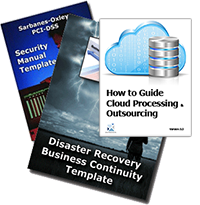- Cloud, Disaster Recovery, and Security come together
Cloud, Disaster Recovery, and Security come together
It is impossible for the CIO to develop an IT strategy without accounting for a distributed workforce - and a mobile one as well
 Today's enterprise looks different than those of the 1990's. Location - headquarters, branch office, home office, or no office - simply doesn't matter anymore. Data lives in a data center and it can be used by anyone everywhere. Decision-making now is more decentralized, with mobile workers and branch office employees making critical decisions on a regular basis. Distributed employees are no longer just ‘sales reps' fulfilling orders, but are highly-paid, highly leveraged knowledge workers. These individuals do not only work with local teams or businesses, but also engage in many-phased collaborations with specialists distributed across the company. The cross functional nature of the distributed workforce significantly changes how a business needs to resource and support both the branch office and the mobile worker.
Today's enterprise looks different than those of the 1990's. Location - headquarters, branch office, home office, or no office - simply doesn't matter anymore. Data lives in a data center and it can be used by anyone everywhere. Decision-making now is more decentralized, with mobile workers and branch office employees making critical decisions on a regular basis. Distributed employees are no longer just ‘sales reps' fulfilling orders, but are highly-paid, highly leveraged knowledge workers. These individuals do not only work with local teams or businesses, but also engage in many-phased collaborations with specialists distributed across the company. The cross functional nature of the distributed workforce significantly changes how a business needs to resource and support both the branch office and the mobile worker.
As more users move towards BYOD and Cloud applications, CIOs are challenged with how to take advantage of business opportunities, people and resources in previously distant markets. This presents a difficult dilemma to a CEO or CIO: Continue to deliver acceptable IT services by throwing money, bandwidth and infrastructure at the problem? Or, save money by consolidating at the expense of the end users? Or use IT to drive new business initiatives?
CIOs need to understand the fundamental trends that are driving CIOs and the businesses they support to redesign their operations around a small set of broad-based imperatives.
- Flexibility and Global Reach - Businesses that have traditionally operated across traditional borders must be able to respond to opportunities and challenges faster than ever before. Businesses now are battling well-resourced organizations that may be based where the opportunity originated, or a globalizing company that is reaching out for new opportunities. In order to compete, a business has to be faster to deliver a product or service as good, or better, than that of potentially any other company in the world.
- Simplicity and Cost Control without Limiting Creativity - With the increased use of the Internet and mobile devices there has led to increased complexity. While per unit costs of technology have decreased, in aggregate companies and CIOs have seen an increase in total cost. With the pressure on CIOs and the organizations they manage to act less as a cost center and more as a way to increase the profitability of business units. At the same time, just adding more storage, more bandwidth, or additional technologies throughout the organization is no longer an acceptable approach to managing information technology. Instead, successful CIOs are investing in technologies like continuous data protection, virtualization, and wireless connectivity to help IT slim down its footprint while increasing their business's competitive advantages.
- Security and Management of Cyber Threats - With the growing executive and user management focus on digital applications and data, the sources of threats to enterprise data have multiplied dramatically. Everything from natural disasters, like the recent weather related events, to criminals to corrupt sources within the company exposes the data assets that are critical components of the overall value added chain they provide. While businesses do everything that they can to stop these threats in the first place, they still must be prepared to recover from these threats as quickly as possible.
- Continuity and Recovery from a Diverse Set of Events - As businesses have expanded, the need for anytime, anywhere application access has become a requirement. At the same time, “follow the sun” (global 24/7) operations have shrinking maintenance windows and a need for applications to be running at all times. Delay or loss of data for any reason - system failure, natural disasters has a domino-like effect across the entire organization, at any time of the day or night.
Janco's Cloud Outsourcing, Disaster Recovery, and Security Bundle provides the tools that are needed to address these issues. The steps to implement these World Class processes are made easy with the Janco's Templates.
Over 3,000 organizations from over 100 countries have used these templates to create the necessary Cloud, Disaster Recovery and Security infrastructure. They have found the process one that is very manageable for companies of all sizes.
Read on...Order Cloud DR/BC Security Bundle Download Selected Pages
